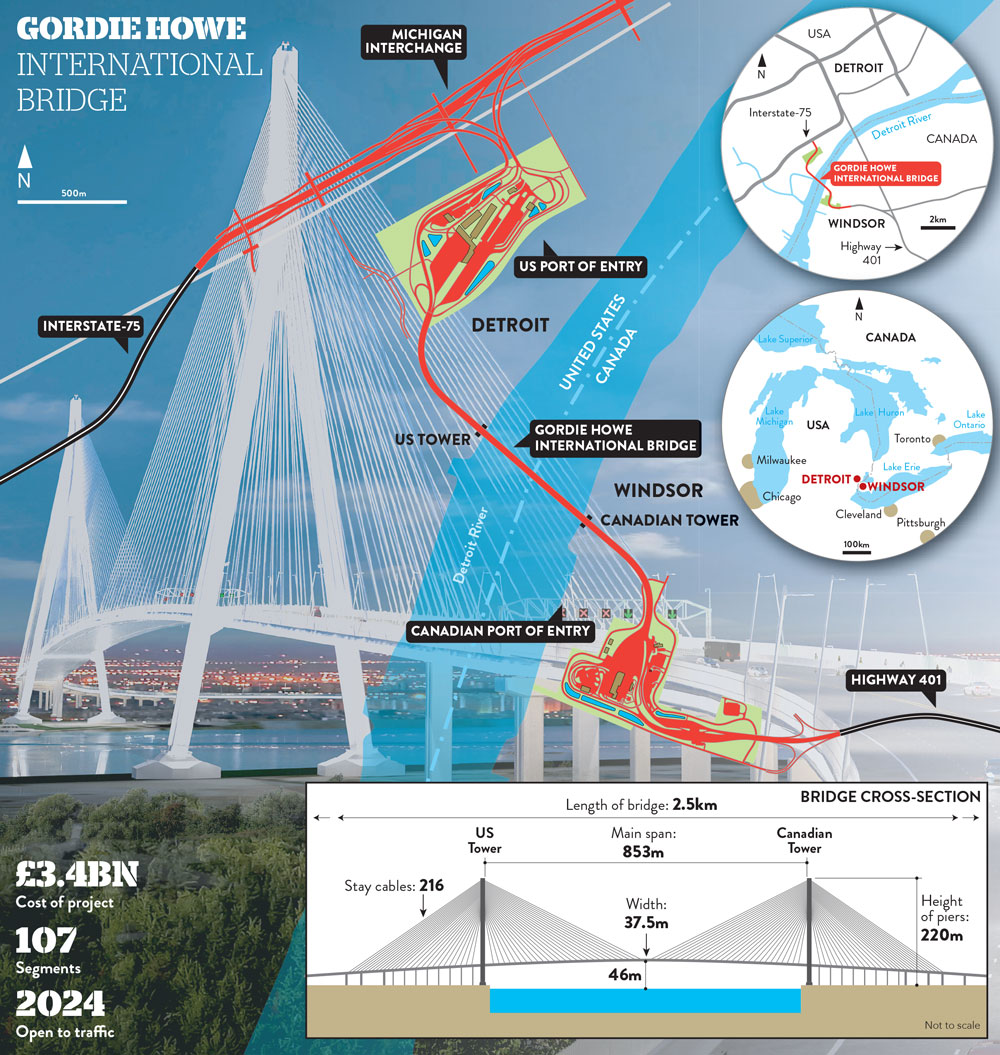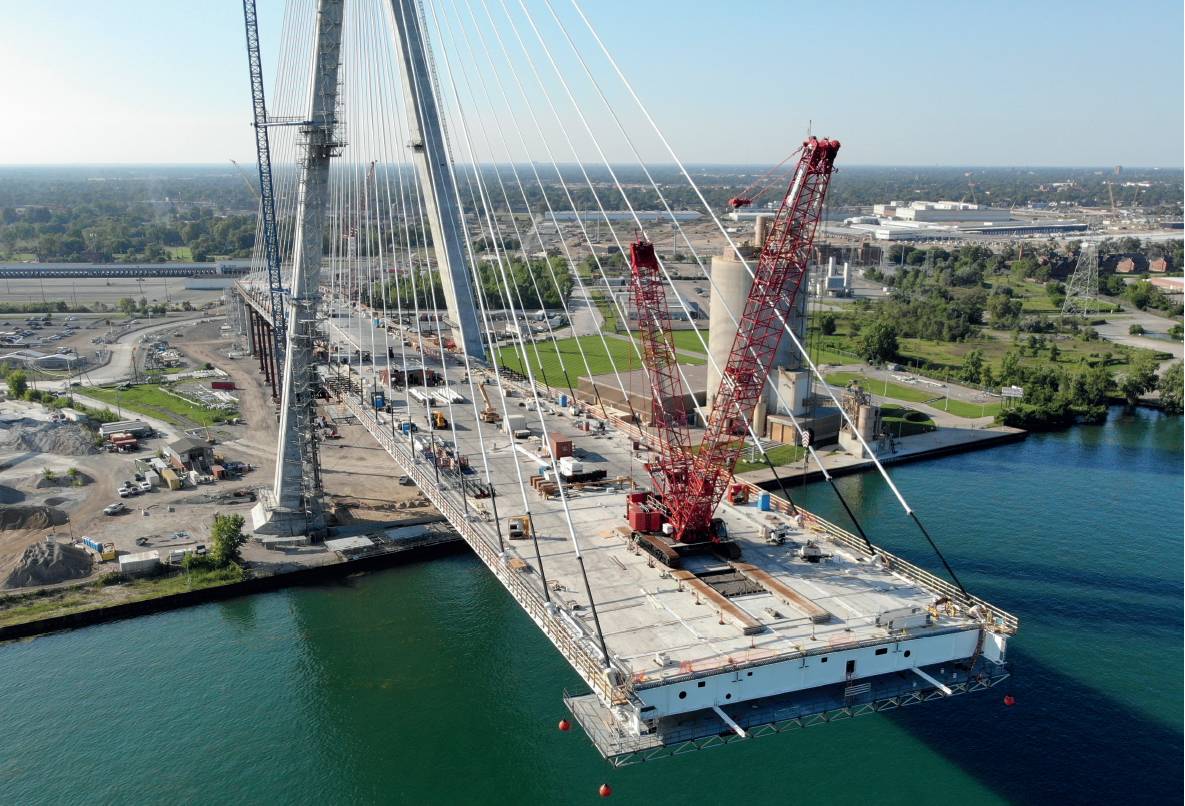Future of Bridges | Gordie Howe International Bridge
Border connection
A new river crossing in a crucial trade corridor between the US and Canada will be the longest cable stayed bridge on the continent and an economic boost for both nations. Rob Hakimian reports.
Canada is the United States’ largest trading partner, with $960.9bn (£769.5bn) worth of commerce having crossed the border in 2022, according to Statistics Canada. The trade corridor across the Detroit River between Detroit in the US and Windsor in Canada is the busiest commercial land border crossing between the two nations. It handles more than a quarter of this trade.
People wanting to cross the Detroit River which forms the US-Canada border already have numerous options. These include the 2.3km Ambassador Bridge, the 1.6km Detroit Windsor Tunnel, the 2.6km Michigan Central Railway Tunnel and the Detroit-Windsor truck ferry.

But the two cities will soon be connected even more robustly by the 2.5km Gordie Howe International Bridge to handle increasing pressure on cross-border capacity.
Once complete, it will be the cable-stayed bridge with the longest main span in North America and the tenth-longest main span in the world.
“It will also be the longest composite deck, cable-stayed bridge in the world,” adds Windsor-Detroit Bridge Authority (WDBA) vice president – engineering Grant Hilbers. WDBA is the corporation responsible for delivering and operating the bridge.
BRIDGE’S IMPORTANCE
As far back as 2000, industry and border stakeholders were voicing concern that the existing crossings would not support the increases in traffic that were anticipated due to increasing population and greater cross-border integration.
State and national authorities from both sides of the border formed the bi-national Border Transportation Partnership. Between 2001 and 2004 the partnership undertook studies to identify a long term strategy to meet the future demands of the region’s transportation networks.
“The study recommended infrastructure projects to address border deficiencies and was used to initiate environmental studies on both sides of the border which led to the development of the Gordie Howe International Bridge project,” explains Hilbers.
The bi-national partnership secured environmental consent for the bridge in 2009 and in 2012 agreements were signed to take the project forward.
WDBA started operations in 2014 and four years later a consortium of contractors known as Bridging North America (BNA) – comprising ACS Infrastructure Canada, Fluor Canada and Aecon – was awarded the contract to design and deliver the crossing.
The bridge will ensure there is sufficient border crossing capacity to handle the growth in traffic. “It will also provide improved border processing capabilities and, for the first time, a highway-to-highway connection that will directly connect traffic to Highway 401 in Windsor and Interstate 75 in Detroit,” Hilbers says.
“The Gordie Howe International Bridge will encourage new investment between Canada and the United States and help to maintain and create thousands of jobs and opportunities on both sides of the border,” he says.
“The government of Canada recognises the importance of ensuring the efficient flow of goods and travellers in the Windsor-Detroit trade corridor.”
KEY FACTS
£769.5bnValue of cross-border trade between the United States and Canada in 2022
853mLength of Gordie Howe International Bridge’s main span
FUNDING
The project is divided into four components: the bridge, the Canadian Port of Entry, the US Port of Entry and the Michigan Interchange with Interstate 75. The project, including all four components, has a fixed price contract valued at C$5.7bn (£3.4bn).
“This includes a six-year design-build phase and a 30-year operation, maintenance and rehabilitation phase,” Hilbers says.
“The Gordie Howe International Bridge will encourage new investment between Canada and the United States
The bridge is being delivered through a public-private partnership (P3) model. “Under a P3, the private sector partner will pay for the design, build, operation and maintenance of all four components of the project,” Hilbers explains.
“Their investment will be repaid [by the Canadian Government] over a concession period.”
The P3 model is beneficial because the private sector’s expertise is utilised to deliver the infrastructure and the companies are paid on performance and for meeting delivery targets. This means that cost or time overruns are shifted from the taxpayer to the private entities. Independent analysis has shown that there will be savings of $562.8M (£462.6M) on this project through using a P3 model as compared to traditional procurement.
DESIGN AND DELIVERY
Including the 853m main span and the approaches, the bridge will be 2.5km long and supported by cable stays from two 220m tall towers – one on either side of the river.
The bridge is 37.5m wide and will carry six lanes of traffic and a multiuse active travel path.
Consultant Aecom is BNA’s lead designer and has ensured that the bridge exceeds US and Canadian building and safety requirements.
The bridge and road deck comprise 107 segments; 56 for the main span and 51 comprising the side spans.
 The bridge will be supported by cable stays from 220m high towers on either side of the Detroit River
The bridge will be supported by cable stays from 220m high towers on either side of the Detroit River
Each segment has two edge girders, nine redundancy girders, three-floor beams, 12 precast panels, 12 soffit panels and two stay cables. There are no piers in the river.
There will be a total of 216 cable stays supporting the deck, split equally between the two towers.
Of these, 212 will be attached to the standard deck segments with another four attached to the non-standard closure segment in the middle of the main span that connects the two sides of the bridge.
“The stay cable design was chosen for its modern and elegant appearance,” Hilbers says. “The towers and stay cables of the Gordie Howe International Bridge will be capable of supporting over 15,000t.”
CONSTRUCTION
Preparatory works began in 2018 and Hilbers says that “last year was the busiest year for construction, with even more progress happening in 2023”. The connections between the side spans and the road networks on both sides are well underway. Construction of the bridge deck began last December and both towers have reached their full height.
Work to tie the bridge into the road network on both sides is also progressing, he adds.
Construction of the bridge deck has been the biggest challenge, Hilbers says, as the method used had to change during construction. BNA had planned to use a classic balanced cantilever approach, with segments successively added to alternate sides of the towers to ensure balance.
“The towers and stay cables of the Gordie Howe International Bridge will be capable of supporting over 15,000tBut “obstructions in early days including limited water access, deep soft clay and winter weather led BNA to re-visit this erection method,” says Hilbers.
Instead, BNA has taken an unbalanced cantilever approach, constructing the side spans first, supporting them on falsework before construction of the main span began.
Another challenge was the execution of deep foundation works close to the Detroit River.
This required the implementation of temporary seawall protection, while artesian groundwater conditions required the implementation of groundwater control plans as well as a special underwater concrete mix design for drilled shaft construction, says Hilbers.
BNA has a contractual obligation to have the bridge open to traffic by the end of 2024 and Hilbers says that the contractor has been making “critical progress to meet this date”.